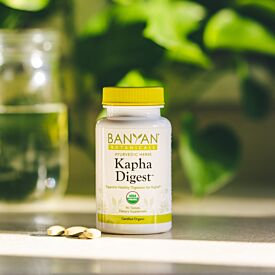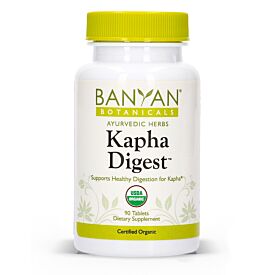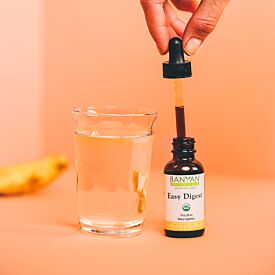20 Minute Kapha Balancing Yoga Sequence
Kapha dosha houses important qualities. We need kapha in order to find stability, balance, and rest. However, having a kapha-predominant prakriti can also maintain qualities of heaviness, slowness, densness, cloudiness, and viscous accumulation. When looking at an exercise routine to kick kapha into gear, it’s a great idea to choose a practice that will move the body.
The regular practice of Sun Salutations (Surya Namaskar) improves circulation of blood, allows heat to accumulate internally, builds strength and stamina, improves the ability to breathe, and maintains overall balanced health in the body. There are numerous benefits of Sun Salutation for the heart, liver, intestine, stomach, chest, throat, and legs. From head to toe, every part of the body is greatly benefitted by this practice, which is why it is highly revered.
Below, I have outlined the Sun Salutation sequence for you to play with and enjoy. Morning is considered to be the best time for Sun Salutations as it revitalizes the body and refreshes the mind, making us ready to take on all tasks of the day. It is recommended to complete five rounds of the below sequence, working in synchronicity with the breath. You will also find a few additional postures to consider implementing as you complete your salutations.

Sun Salutation
Mountain Pose (Tadasana):
Stand with your big toes together and your heels slightly apart. Begin to root your energy through your big toe mound and then spread it out towards the pinky toe side of the foot, finally resting back into the horse shoe of the heel. Find balance in this triangular placement of the feet. Lift the inner arch of the feet gently, bringing energy up through the inseam of the leg. Engage the tops of the thighs, keeping the knees soft. Draw the lower belly in and up, finding strength in the core and length in the chest. Widen the shoulder heads apart, drawing the shoulder blades more closely together behind the back. Strengthen the musculature of the upper arms and extend the fingers actively towards the floor. Remove any wrinkles from the back of the neck and reach the crown of the head into the sky. Begin to cultivate slow, steady breathing using Ujjayi Pranayama.
Upward Salute (Urdhva Hastasana):
On an inhalation, slowly begin to reach the arms into the sky until the palms press firmly together. Tilt the chin up in order to gaze softly at the hands. Feel the rib cage lift and lighten and draw the belly further in to create length. Focus on reaching all the way from the base of the feet to the tips of the fingers.
Standing Forward Bend (Uttanasana):
As you begin to exhale lead with your heart; opening your arms wide fold the torso down over the legs, hinging at the hips. Contract the belly in and up and activate the thighs as you bend. Take the weight towards the balls of your feet keeping the toes soft, becoming slightly lighter in the heel, and completely relax your neck. Reach your fingertips towards the floor, and if you can’t quite reach, choose to either bend the knees or place your hands on yoga blocks.
Standing Half Forward Bend (Ardha Uttanasana):
Inhaling, bring the spine up into a parallel position to the floor. If you were to look at your body, you are essentially creating a 90-degree angle between the legs and the back. Lengthen the side ribs, reaching the heart forward and the shoulders back. Keep the back of the neck long and the crown of the head extending forward and out. Root the hands either on the shins, yoga blocks, or place the fingertips in line with the toes.
Plank Pose (High Pushup):
Exhaling, step back and come into the top of a push up. Spread your fingers, evenly distributing the weight in each finger pad. Place emphasis on the thumb and index fingers of each hand in order to protect the outer wrists. Push firmly down and begin to rotate gently the crease of the elbows to face forward and out. Align the shoulders directly over the wrists. Wrap the upper arm bones away from the ears. Puff up the space between the shoulder blades, as though you were rounding your back ever so slightly. This will support you with core engagement. Activate the core awake by gently drawing the tailbone down. This action will also begin to activate the thighs. Stack the heels directly above the balls of the feet. Using oppositional energy reach all the way from the crown of the head to the heels drawing a dynamic straight line with the body.
Four-Limbed Staff Pose (Chaturanga Dandasana):
Normally on the same exhalation from Plank Pose, begin to tip towards the top of the toes, bringing the shoulders slightly forward of the wrists. Slowly lower down bringing the shoulders into a 90-degree angle with the elbows. Pause in this low position releasing the full length of the exhalation. Focus on broadening through the collar bones, strengthening through the core and activating the legs. The gaze is slightly forward and soft. The body is fully engaged here from head to toe!
Note: This posture is often passed through quickly by students, but it’s very important to fully appreciate this pose and move articulately. If needed, lower the knees to the mat for additional support as you work to build your arm strength.
Upward Facing Dog (Urdhva Mukha Svanasana):
On an inhalation, press the toes back and slide onto the tops of the feet. Press the hands firmly into the ground as you begin to straighten the arms, once again aligning the shoulders above the wrists. Be mindful to utilize the thumb and index finger to bear most of the weight. Keeping the gaze straight ahead, focus on elongating through the back of the neck as the spine gently lifts into this backbend. Draw the heads of the shoulders back, spreading through the collar bones, opening the heart. The pelvis is buoyant and the thighs and knees are actively lifting off of the ground.
Downward Facing Dog (Adho Mukha Svanasana):
Exhaling, draw energy from the lower abdominal muscles and lift the hips towards the ceiling as you gently roll over all ten toes, finding a full triangular shape in the body (if this is too difficult, skip it and just place the soles of your feet onto the mat). Starting at the feet, lengthen the toes towards the fingers, lifting them ever so slightly. This will allow the heels to further descend towards the floor. Push the top of your thighs back and energetically create an internal rotation towards the midline of the body. Straighten at your knees; however, work to not lock them. Draw the lower belly in and up, creating an anterior tilt in the pelvis. Engage the lower ribs in, as to maintain integrity in the torso. Press your hands deeply into the ground, once again being mindful of resting the majority of the weight towards the thumb and index fingers. Firm your shoulder blades against your back, then widen and draw them toward the tailbone. Let the head relax and take five slow deep rounds of breath.
Repeat the below postures until you arrive back to the beginning.
Standing Half Forward Bend (Arha Uttansana)
Standing Forward Bend (Uttanasana)
Upward Salute (Urdhva Hastasana)

Additional Postures:
Chair Pose (Utkatasana)
With your big toes touching and your heels slightly apart, begin to bend your knees and sink your hips down. Take the weight of the body into the heels of the feet and lift all ten toes carefully off the mat. Internally rotate your thighs, drawing energy towards the midline of the body. Engage your stomach muscles, activating a natural lift in both the core and the chest while relaxing the low back. Extend the arms towards the sky, working the upper arms by or behind the ears, with the fingers strongly reaching upward. Another name for this pose is “lightning bolt,” so embody that energy, be fierce!
Revolved Chair Pose (Parivrtta Utkatasana):
With your big toes touching and your heels slightly apart, begin to bend your knees and sink your hips down while reaching your arms into the sky, resting into Chair Pose. Keep your knees aligned. Move the weight of the body towards the heels and lighten the energy in the toes. Place the hands together in front of the heart and take a full inhalation. As you exhale, begin to hook your right elbow over and onto your outer left knee. Press the palms together firmly, rolling your left shoulder back, working to bring your thumbs towards your sternum. Stay here and take 5 breaths, then switch and twist left.
Side Plank Pose (Vasithasana):
From Plank Pose, place your right hand at the center of your mat. Carefully begin to roll towards the outer right-side edges of your feet. You can choose to either stack the feet one on top of the other (full variation) or stagger the feet heel to toe (modified variation) and flex your toes towards your knees. With your right shoulder stacked above your right wrist, engage your left arm straight into the sky. Arch through your hips creating a dynamic bend in the body. The core is activated to support this midline loft. You can keep your head neutral or begin to turn your gaze upwards as your balance strengthens.
Half Lord of the Fishes Pose (Ardha Matsyasana):
Sit on the ground with your legs outstretched. Bend your right knee towards your chest and place your right foot to the mat just outside the left knee. Inhale, lift your left arm. Exhale, twist over to the right and hook your elbow on the outside of your left knee. Stay here and breathe for 5 breaths, and then switch your legs and twist left.
Child’s Pose (Balasana):
Begin kneeling on the floor with your big toes touching together and gently rest back on your toes. Separate your knees approximately hips distance apart. With an exhalation soften your torso between your thighs. Outstretch your arms in front of you with the palms turned face down for a more active variation of the pose, or rest the arms alongside your body with the palms turned upward for a more passive variation of the posture. Both variations are very restorative. From here simply close your eyes, and rest in this position for approximately 5–10 breaths.
The most important thing to remember when entering into a yoga practice is that INTENTION is everything. Your body will go where your mind goes, and vice versa, so even if you’re practicing the “right” postures and styles of yoga to balance kapha, if you’re struggling to commit to the practice or complete it, your practice will not have the balancing effect that you desire and need. Setting intention of movement, breath, mind, and consistency is key.
Good luck! Asana on!












